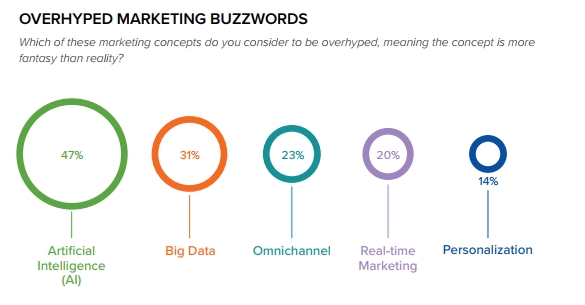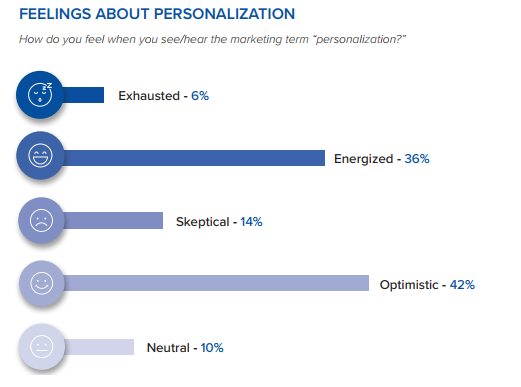Reality Check On Overhyped Marketing Buzzwords
As you may already know, as the CMS-Connected team, we often attend some significant tech  providers’ annual user conferences to capture the buzz of their events through our interviews with the attendees. During those conversations, more often than not, we notice the same gap between technology providers’ executives and actual users. Personalization, big data, omnichannel, real-time marketing, voice assistants, artificial intelligence, applications, and all other buzzwords have been thrown into every conversation at those events but when we go in-depth on actual use cases, often times the hype on the new technologies aforementioned seems to outpace the reality and practicality.
providers’ annual user conferences to capture the buzz of their events through our interviews with the attendees. During those conversations, more often than not, we notice the same gap between technology providers’ executives and actual users. Personalization, big data, omnichannel, real-time marketing, voice assistants, artificial intelligence, applications, and all other buzzwords have been thrown into every conversation at those events but when we go in-depth on actual use cases, often times the hype on the new technologies aforementioned seems to outpace the reality and practicality.
Instead of frothing up the bubble on the hype, a marketing automation platform provider, Resulticks, conducted a study to see the real story behind the fancy martech world. In the end, the study concluded that most marketing technology solutions have overpromised and under-delivered, leaving marketers ready to throw in the towel. In fact, 75% of marketers say they can’t meet their goals with their current martech software; even brands that have invested in marketing suites have struggled to get in shape, despite these all-in-one solutions promising the world, Resulticks claims.
In my view, I do not think marketing technologies are purely the culprit here as when it comes to a broad adoption of any technology, there are so many moving parts, from training, change management to digital maturity, to make that platform work for the entirety of your organization. Additionally, I don’t believe, having hype or excitement around new technologies is necessarily a negative situation as it demonstrates a strong commitment of marketers and marketing technology providers to innovation. Therefore, in this article, first we will do a reality check on how much some “table stake” technologies have been really adopted, in light of the study mentioned, and from there, we will take a closer look at how marketers can get more innovative with content in 2018 by actually taking advantage of those hyped technologies.

Has Big Data Become Too Big for Marketers?
According to Resulticks research, more than a third (34%) now say they are exhausted by the term. As far as the buzzword blame game goes, only 21% of marketers say their software delivers on all its big data promises. To me, the main barrier for the rest is either collecting data or the process of translating it into the next best actions. Considering the explosion of data and ways of gathering it, I would say it is most likely the latter. Unfortunately, a large amount of data generated by consumers in the process of decision-making frequently goes unused. In fact, the same study found that a whopping 20% have given up on the concept completely.
Being armed with big data helps marketers uncover hidden opportunities and competitive threats - turning negative customer feedback into promotion, eliminating biased decision-making processes as they take the guesswork out of customer relationships, and gaining a broader view of their positioning against the competitors to name a few. After all, data is the only power they have to be able to see which steps happen online, which steps happen offline, whether the entire journey is completed through only one digital channel, say, their website, or do visitors wander among different channels.
What Went Wrong with Personalization?
Marketers were supposed to break through the personalization plateau with data cross-training as Resulticks pointed out. However, in reality, many organizations are having difficulty with personalization. Far worse, the same study demonstrates that 25% are just getting started on implementation and need help warming up.

Considering personalization has been a very hot topic in the marketing world for several years now, one would assume that by this point in time we have gone past that. Given that personalization is a sophisticated and complex area, there is an exchange of profitable benefit to the organizations for a little bit of time and effort being given away. The time and effort referred to here mostly go into setting up a clear alignment on the goals, execution, deployment, and strategy.
Why do you think it has taken so long for merchandisers and marketers to deliver a consistent and personalized experience across channels? When attending Sitecore Symposium 2017, we were fortunate enough to capture all of the different, invaluable perspectives directly from the event floor. While doing so, we asked this question of Sitecore’s two seasoned executives, Joe Henriques and Ryan Donovan as the vendor announced another interesting finding from recent research: 96% of 6800 customer respondents believe many brands are in fact, providing “bad personalization,” which upon deeper analysis, is no personalization at all. To sum up and combine their comments on the matter: “The most common mistake is that a lot of brands are trying to go all in and too fast without achieving a certain level of personalization where they can really benefit from personalization.”
I definitely agree with these gentlemen as cracking the consumer code really takes lots of experiments based on data and time. With every experiment yielding a different result, brands will come up with more rich and informed ideas to determine which direction to go.
Still a Long Road to Omnichannel Success?
The once well-defined line between content marketing channels has now shrunk. In fact, research by Aspect Software suggests that about 91% of customers want to pick up where they left off, from one channel to the next. Successful organizations have long recognized the importance of creating a consistent experience across all digital touch points thus content management platform makers incorporated omnichannel features to help brands meet today’s customers’ expectation. Considering content is the heart and soul of every strategy, omnichannel marketing strategy has become one of the main focus areas for marketing technology providers as well.
Despite the obvious benefits of omnichannel marketing and the positive outlook from marketers, the National Retail Federation (NRT) declared in early 2017, it’s still a “long road to omnichannel success". NRT claims that although better use and integration of existing technologies as well as investments in new solutions have significantly improved efforts to deliver on the omnichannel promise, even the top-ranking retailer received a rating of 76%. As this figure comes from a customer perspective, to understand a marketer perspective, the Resulticks study unveils that only 9% of marketers describe their strategy as “omnichannel” today. Omnichannel remains a priority for only 20% of marketers, and many are ambivalent about the concept.
When it comes to implementation, 35% of marketers are reporting full or partial implementation and 30% are saying they have no plans to implement omnichannel, or that they have abandoned the idea entirely. More interestingly, the majority of marketers (58%) surveyed place the blame for the limited growth in integration progress on vendors’, “execution poor or fair on omnichannel.”
Not to play devil’s advocate, but to me, there are so many basic and yet untapped omnichannel capabilities at marketers’ disposal such as seizing customer data at point of purchase simply by suggesting to send the receipt via email after their shopping. That being said, there are also more complex omnichannel capabilities that need to be embraced after getting the basics right.
Real-Time Marketing is Widely Adopted
Maybe, one of the most infamous real-world examples of real-time marketing took place on February 3, 2013, during the Super Bowl. The lights went out for 34 minutes during the game and Oreo and its agency took advantage of that incident to shine its own light on the marketing world via this witty and timely tweet:
Fast-forwarding over four years, fortunately, the Resulticks research findings on real-time marketing are not as dramatic as omnichannel because the results illustrate that “marketers are mostly energized (34%) and optimistic (36%) about real-time marketing, and almost half consider it a priority for their organizations (47%).” The higher maturity might have something to do with the fact that the term of real-time marketing was born back in the 1990s so it has been around quite a while now.
Marketers Feel Skeptical about Artificial Intelligence
I am sure by now, you have heard the phrase that has been thrown around quite a lot by mostly venture capitalists: “Artificial Intelligence (AI) is the new mobile.” The reason why this phrase has been echoed in the tech industry is to emphasize that AI is not a short-lived fad, rather a revolution like mobile. More importantly, they seem to be right as in the last five years, giant tech companies have been pouring money into this technology.
The conference that was held at Dartmouth in 1956, is still considered the biggest groundbreaking event in the artificial intelligence field. Although it was believed that machines would be capable of using natural language, solving problems, simulating every aspect of learning and any other feature of intelligence within two decades, by the 1970’s, the period known as the AI winter had taken hold due to reduced funding and a lack of interest in artificial intelligence research. The enthusiasm around AI has cautiously grown since its low point in 1990, and in 2011, IBM’s Watson system beat the best human players in the game show Jeopardy! From there, it started to pick up speed. In fact, over 200 private companies using AI algorithms across different verticals have been acquired since 2012, with over 30 acquisitions taking place in Q1’17 alone.
Based on the results of its study, Resulticks states: “Almost half (47%) of marketers already consider AI to be overhyped, far more than other industry buzzwords, and 40% feel skeptical when they see or hear the term.” According to Forbes, marketers predict that their use of artificial intelligence will grow faster than their adoption of all other technology in the near future; more than 50 percent plan to adopt AI in the next two years. So where does this gap come from? According to Resulticks study, marketers haven’t been so impressed by what marketing technology providers have delivered in that department so far — 43 percent believe martech software overpromises and under-delivers on artificial intelligence, and 69 percent rate their vendors’ ability to help them execute on AI as “poor” or “fair.”
Before sharing my point of view, let me encapsulate the most interesting takeaways from the study:
-
Almost half of marketers think artificial intelligence is an overhyped industry buzzword, and 40% feel skeptical when they see or hear the term.
-
More than a third of marketers are exhausted by ‘big data’ and 20% have given up on the concept completely.
-
To be honest, I am still appalled by this finding - only 9% of brands describe their marketing strategy as omnichannel, and 30% say they have no plans to implement omnichannel, or that they have abandoned the idea entirely.
-
On the other hand, 36% feel optimistic and 34% feel energized about real-time marketing.
My POV
First things first, just because personalization, big data, omnichannel, real-time marketing, and artificial intelligence have lately become some sort of buzzwords that have been thrown into every conversation, doesn’t mean they are here today and gone tomorrow. The reason they have turned into overhyped and overused marketing tactics and come to the point of creating market confusion is the fact that they are not merely reliant on technology.
As I indicated earlier, there are many moving parts in any technology adoption strategy. The slow progress sometimes might have something to do with your audience’s readiness. For example, the option of buying online and picking up in the store is one of the most known omnichannel best practices but some retailers might see a slow and steady adoption rate, comparing to other digital initiatives. It means neither their marketing team nor technology provider sucks. It is simply the result of the pace of their audience's reaction to that option. On the other hand, in other scenarios, they definitely will need a technology that has a strong back-end and administrative capabilities that would fully support your omnichannel strategy.
Although in the upcoming days, we will publish a deeper piece on enterprise tech trends for 2018, for now, to become a more innovative content marketer by taking advantage of these revolutionary concepts and more, here is some food for thought:
-
When we inject “intelligence” into content management systems, from automating menial tasks to analyzing the tone of each piece of content, the possibilities are endless. However, to give an example, the integration between content management systems and text-to-speech technology has lately been garnering a great interest in the industry. Among many benefits, text-to-speech enables digital businesses to make their content more accessible and consumable.
-
The explosion of mobile apps reached a tipping point in 2008. The technology finally settled in and passed the torch to these support applications called bots. Today, more and more enterprises are making strategic bets on conversational, bot-powered services as the next vehicle for business interactions to drive better customer and employee engagement. Chatbots, for instance, have been utilized by retailers to grasp consumer habits, context, and intent to better predict and provide the content, information or engagement today’s customers are seeking. Now, B2B brands are catching on creating more innovative business cases as well.
-
The point of gathering data is to be able to translate all the data into meaningful actions. However, due to the ongoing explosion in the volume of data collected, many organizations are living in irony where they gather too much data but know too little about what this data represents. Some analytics platforms powered by cognitive computing technologies have even started going beyond conventional text analysis to deep semantic analytics to provide an in-depth understanding. In 2018, many more marketing organizations will look into these advanced analytics platforms.
Before you go, I would like to put a smile on your face with sharing this entertaining video below as it mocks the most common buzzwords used in a white-collar world:

Venus Tamturk
Venus is the Media Reporter for CMS-Connected, with one of her tasks to write thorough articles by creating the most up-to-date and engaging content using B2B digital marketing. She enjoys increasing brand equity and conversion through the strategic use of social media channels and integrated media marketing plans.